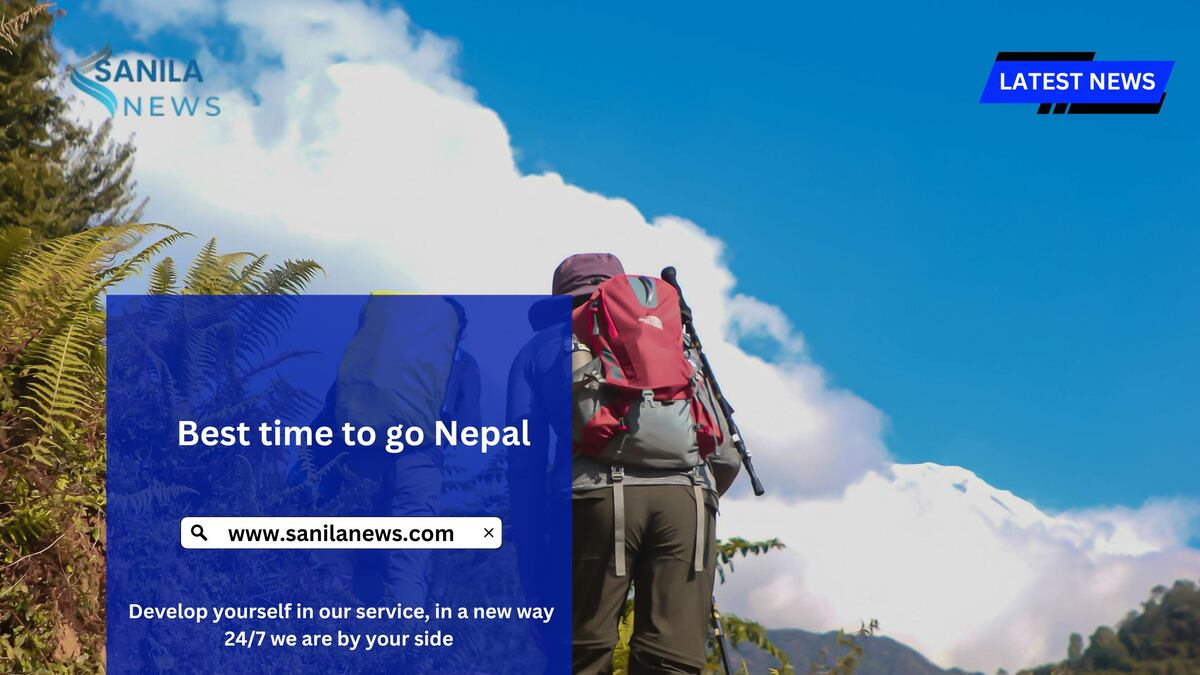Best Time to go Nepal: A Comprehensive Guide
Nepal, a land of mystical mountains, ancient temples, diverse cultures, and natural beauty, attracts travelers from around the world. Nestled between the giants of China and India, this Himalayan nation offers some of the most stunning landscapes and thrilling adventures. From trekking the iconic Everest Base Camp to exploring Kathmandu’s UNESCO World Heritage sites, Nepal has something for everyone. But, like any destination, timing your visit to Nepal is crucial to making the most of your experience This guide explores the best time to go Nepal, taking into consideration factors such as weather, trekking seasons, festivals, and activities. Whether you are an adventurer looking for outdoor thrills or a cultural enthusiast interested in Nepal’s rich traditions, understanding the seasons and climate will help you plan your trip perfectly.
Climate Overview: The Four Seasons of best time to go Nepal
Best time to go Nepal experiences four distinct seasons: spring, summer (monsoon), autumn, and winter. Each season offers a unique experience, with its pros and cons.
- Spring (March to May)
- Summer/Monsoon (June to August)
- Autumn (September to November)
- Winter (December to February)
1. Spring (March to May): Blossoms and Clear Skies
Weather: Spring is one of the most popular seasons for visiting Nepal. The weather during this period is mild, with temperatures ranging from 16°C to 23°C in Kathmandu. The skies are mostly clear, especially in the higher altitudes, making it ideal for trekking and outdoor activities. Lower altitudes can be warmer, while the upper regions, such as the Everest Base Camp, remain cooler but manageable.
Trekking: For trekking enthusiasts, spring is the second most popular time of the year. The trails are alive with blooming rhododendrons and other wildflowers, turning the hillsides into a colorful spectacle. The famous Everest Base Camp and Annapurna Circuit treks are highly recommended during this period. Additionally, trekkers can enjoy clear views of the majestic Himalayan peaks.
Cultural Highlights: Spring in Nepal also coincides with some of the country’s most significant festivals. The Holi festival (the festival of colors) and Bisket Jatra (Nepali New Year) offer unique insights into the local culture and traditions. These events bring communities together in vibrant celebrations.
Pros:
- Mild weather and pleasant temperatures.
- Clear mountain views.
- Blooming flowers along trekking trails.
Cons:
- Increasing crowds as the season progresses.
- Higher prices for accommodation in popular trekking areas.
2. Summer/Monsoon (June to August): Lush Greenery and Rains
Weather: Best time to go nepal the summer season in Nepal coincides with the monsoon, which brings heavy rainfall, particularly in the central and southern regions. Temperatures can soar up to 30°C in Kathmandu, while the humidity adds to the intensity of the heat. Rainfall is more concentrated in the afternoons and evenings, while mornings are often clearer.
Trekking: Best time to go nepal the monsoon season is not the best time for trekking in most regions due to slippery trails, landslides, and reduced visibility. However, if you’re an adventurous trekker, some areas in the rain-shadow regions, such as Upper Mustang and Dolpo, remain relatively dry and are ideal for trekking during this season.
Cultural Highlights: Despite the wet weather, monsoon is a vibrant time for agriculture, with terraced fields turning a brilliant green as rice paddies are planted. The monsoon also brings about the celebration of unique festivals such as Ropain (Rice Planting Festival) and Teej, a women’s festival of fasting and prayer for marital bliss.
Pros:
- Lush, green landscapes and vibrant rice fields.
- Fewer tourists and lower prices for accommodation and trekking permits.
- Ideal time to explore rain-shadow areas like Upper Mustang.
Cons:
- Heavy rainfall and potential for landslides.
- Poor trekking conditions in most regions.
- Reduced visibility of mountains due to clouds and mist.
3. Autumn (September to November): Clear Views and Festivities
Weather: Autumn is the most popular season for visiting Nepal, especially for trekkers and adventure seekers. The monsoon rains have passed, leaving behind fresh, clear air. Temperatures range between 15°C and 24°C in Kathmandu, with cooler temperatures at higher altitudes. The skies are crystal clear, offering some of the best mountain views of the year.
Trekking: Autumn is peak trekking season in Nepal, and for good reason. The trails are in excellent condition after the monsoon, and the visibility is at its best. Whether you’re trekking the Annapurna Circuit, Langtang Valley, or Everest Base Camp, this is the ideal time. Popular trekking routes can be crowded, so booking in advance is advisable.
Cultural Highlights: Autumn is also a time of significant cultural festivities in Nepal. The two biggest festivals, Dashain and Tihar, occur during this season. Dashain, the longest and most celebrated festival, involves family gatherings, feasts, and religious ceremonies. Tihar, the festival of lights, follows shortly after, with five days of worshiping different deities, animals, and family members. Travelers can immerse themselves in these vibrant cultural celebrations during their visit.
Pros:
- Clear skies and the best visibility of the mountains.
- Ideal trekking conditions on most routes.
- The festive season offers cultural immersion opportunities.
Cons:
- Popular trekking routes are crowded.
- Higher prices for accommodation and services due to peak season demand.
4. Winter (December to February): Tranquility and Snow-Covered Peaks
Weather: Winter in Nepal brings cold temperatures, especially in the mountainous regions. In Kathmandu, temperatures range from 2°C to 15°C, while in higher altitudes, it can drop well below freezing. The skies remain clear, but snow is common at higher elevations, which can make trekking more challenging.
Trekking: While winter is off-peak for trekking, it is still possible to trek in certain areas. Lower-altitude treks like the Ghorepani Poon Hill or the Kathmandu Valley treks are good options. The trails are much quieter, offering solitude for those who prefer a more peaceful experience. High-altitude treks like Everest Base Camp are still feasible but require more preparation and appropriate gear due to the extreme cold and snow.
Cultural Highlights: Winter in Nepal sees fewer festivals compared to other seasons, but it’s still an excellent time to explore the cultural and historical sites of Kathmandu, Bhaktapur, and Patan without the crowds. Additionally, the Himalayan views are exceptionally crisp during the winter months, making it a great time for photography.
Pros:
- Fewer tourists and more peaceful trekking trails.
- Crystal clear skies for photography and mountain views.
- Lower prices for accommodation and trekking permits.
Cons:
- Cold temperatures, especially at higher altitudes.
- Snow may block some trekking routes.
Best Time Based on Activities
- Trekking: If trekking is your primary reason for visiting Nepal, then spring (March to May) and autumn (September to November) are the best seasons. The weather is stable, and the trails offer the most scenic beauty and clear views.
- Wildlife Safari: For those interested in wildlife and visiting places like Chitwan or Bardia National Park, the winter months (December to February) are ideal. The cooler temperatures drive animals out of the dense jungle, making it easier to spot wildlife like tigers, rhinos, and elephants.
- Cultural Exploration: Nepal’s cultural festivals are spread throughout the year. If you want to experience local traditions and festivals, plan your visit around Dashain and Tihar in autumn or Holi and Nepali New Year in spring.
- Mountaineering: For high-altitude mountaineers, pre-monsoon (late spring) and post-monsoon (early autumn) are the best times to climb peaks such as Everest, Lhotse, or Manaslu. The weather is stable, and the conditions are favorable for expeditions.
Final Thoughts: Tailoring Your Trip to the Best Season
The best time to go Nepal depends on what you want to experience. Each season offers something unique:
- Spring is perfect for those seeking moderate weather, blooming landscapes, and cultural festivals.
- Autumn is ideal for trekkers looking for clear skies and the most stable weather conditions.
- Winter provides tranquility, crisp mountain views, and lower-altitude trekking opportunities.
- Monsoon is great for exploring lush landscapes, rain-shadow areas, and participating in agricultural festivals.
Ultimately, Nepal’s beauty and charm can be enjoyed year-round, but understanding the climate and aligning it with your interests will ensure you have the best possible experience. Whether you’re trekking in the Himalayas, engaging in cultural exploration, or enjoying the serenity of Nepal’s natural beauty, timing your trip to the right season is the key to a memorable journey.
4o
Last word
Keep an eye on our news channel Sanila News to get updated news regularly.

